
Museum Catalog Number: ZION 9558 There is a long history of women living, exploring and working among the canyons and cliffs of Zion National Park. Most of these women have existed in histories often relegated to the margins, but their lives as naturalists, rangers, writers, artists, adventurers, and workers have shaped Zion into the renowned park that it is today. Uncovering this history provides insight not only to women’s expanding roles in twentieth century American society, but also their unique experiences working for the National Park Service. The legacies that these women leave highlight more nuanced histories at Zion. AdventurersClimbers, hikers and adventurers have long flocked to Zion National Park to walk among its canyons and upon the cliffs, including many women during the park’s early years. 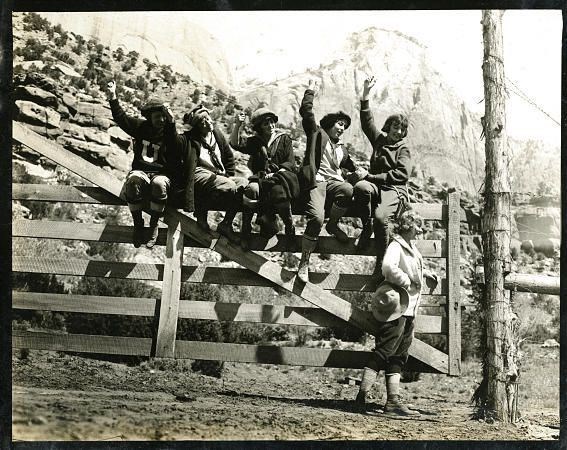
Union Pacific Railroad Photo After its designation as a National Park, Zion welcomed its first group of official visitors, six young women from the University of Utah who spent eight days hiking and climbing within the park. On Zion National Park’s opening day in 1920, the students Nell Creer, Ann Widtsoe, Mildred Gerrard, Dora Montague, Melba Dunyon, along with their chaperone Catherine Levering entered Zion as the park’s first visitors. These adventurous climbers, outfitted in pants and boots, carried ropes and all the necessary equipment to scramble up boulders and scale sandstone cliffs. Their trip was paid for and documented by the Union Pacific Railroad Company as a way to encourage tourism to the region. The daring photos of this intrepid group, which were published in newspapers across the country, captured their bravery and spirit along with the park’s unique landscapes. ArtistsZion National Park’s stunning landscapes have inspired artists for generations, including several well-known women artists. 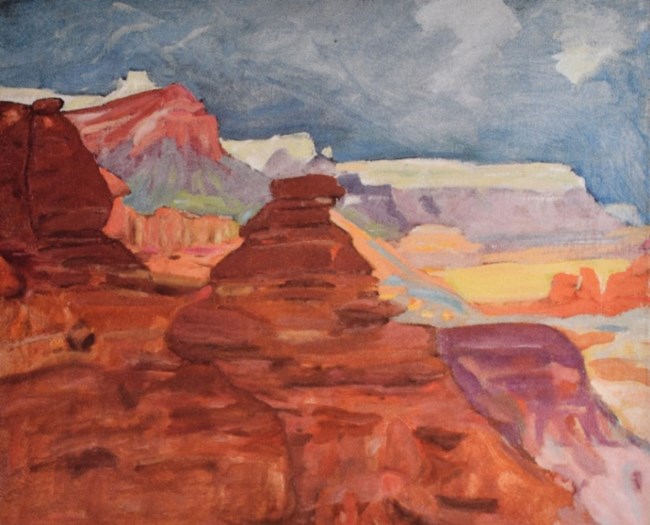
Image from A Century of Sanctuary, The Art of Zion National Park. Zion Natural History Association, 2008, p. 42 Landscape artist Mary Russell Ferrell Colton painted Western scenes the early 1910s to 1940s, including Zion National Park in 1930. “We travel rough roads in life and we all know that there are many joys that slip away and many disappointments along the road, but if we have a love of beauty, life will hold many satisfactions for us which we cannot lose, and we can feel that is has been worth while." 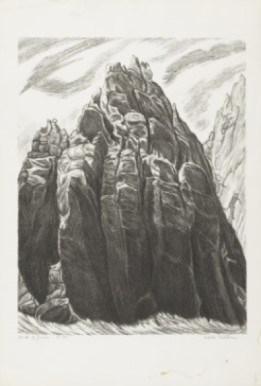
Norton Museum of Art, Pasadena, CA Another woman artist whose work captured the beauty of Zion was printmaker and painter Adele Watson. Born in 1875, Watson studied in Europe before settling in the United States, maintaining residences in both New York and Pasadena, California. An accomplished landscape painter, Watson traveled through the country painting coastal scenes, sweeping plains and dramatic cliffs, notably in Zion and Bryce Canyon. While in Utah, Watson developed her unique anthropomorphic styles in her work, portraying bodies and faces within the rock shapes. This style earned her praise from the art community and in 1933, the Los Angeles Times’ art critic, Arthur Millier, wrote, "Miss Watson's work, recently described in these columns, consists principally of landscape, which, seen by the artist's imagination, discloses figures flying in the clouds, struggling for release from desert rocks or lying gracefully along the valleys. Miss Watson's vision are convincing and, at their best, quite beautiful. Her work has no parallel in this region.” 
Southern Utah University, Gerald R. Sherratt Library, Utah Parks Company Collection Zion Lodge WorkersBuilt in 1925 in the park’s main canyon, the Zion Lodge has employed many people over the years. In its early years, both men and women worked there as housekeepers, waiters, tour operators, and more. One of these employees was Lulu Slack Price. Born and raised in nearby Toquerville, Utah, she began working for the Zion Lodge in the late 1920s and stayed there for 3 seasons. Every night, she was part of the lodge’s musical programs, where the employees would dance and sing for the guests. Price and her coworkers would spend their weekends hiking and exploring the park. She went on to work at Bryce Canyon and a resort in Sun Valley, Idaho after her time at Zion, but in a 2004 oral history interview, she said, “I’ll tell you right now, you haven’t lived until you’ve worked in Zion National Park.” Superintendent WivesIn the early decades of the National Park Service, parks relied on the wives of rangers, superintendents and other male employees to perform a wide range of unpaid duties. “Park wives” as they were generally called didn’t just assist their husbands; many led tours, served as fire lookouts, responded to emergencies, and even fed park visitors at times in their homes. A few “park wives” worked as rangers or naturalists themselves before marrying co-workers. Most women resigned upon marriage but a few continued working for a short period afterward. 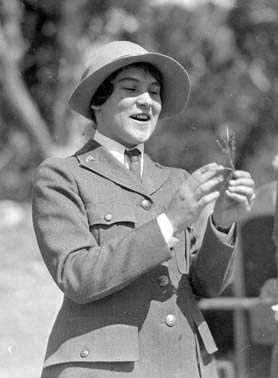
Grand Canyon National Park Photo Pauline “Polly” Mead Patraw was the first woman ranger-naturalists at Grand Canyon National Park. She was a highly respected botanist. She had studied plants in southern Utah before focusing her master’s degree research on the plants of the Grand Canyon. Turned down by the U.S. Forest Service because she was a woman, she was hired by the NPS in 1929. She worked as a temporary ranger-naturalist from 1929-1931. Mead married the park’s assistant superintendent, Preston P. Patraw, in May 1931 and resigned from the NP S. The Patraws moved to Zion in 1932 after Preston became superintendent. In addition to her duties as a superintendent’s wife, Polly collected plants in the park and wrote articles for Zion’s Nature Notes. She also co-authored Plants of Zion Park in 1937 with park naturalist C.C. Presnall and wrote Flowers of the Southwest Mesas in 1951. National Park Service Director Horace Albright later recalled that part of his decision to appoint him was Polly’s knowledge of the resource, saying “They made a lot of fun of me for a long time, that the director was really for Polly, not Pat.” Ranger-NaturalistsThe first women park rangers were hired in 1918. At least 20 women rangers were hired between 1918 and 1927 before the NPS decided to stop hiring women under the “park ranger” title to protect the romance of the ranger image. Of course, the NPS still needed women to undertake ranger duties, particularly in the remote Western parks. In 1928, the ranger-naturalist title was created to avoid giving women the ranger title. However, men quickly worked to exclude women from the ranger-naturalist positions as well and only a small number of women were hired for these jobs over the next three decades.
Wealthy Purrington Spreng was the first known female park ranger-naturalist who worked at Zion National Park in 1946. After graduating from Brigham Young University with a degree in geology, she was hired as a seasonal naturalist in the park. Purrington Spreng worked one season at Zion and then spent the following season at Yellowstone National Park. After working with the Park Service, she attended the University of Kansas for a Master’s degree in geology, where she met her husband. They then moved to Missouri where they both worked at a local university for many years. Zion didn’t hire another woman naturalist until 1959. Prior to working for the NPS, Barbara Chidsey taught biology in Turkey and at the University of California, Davis. She spent the summer at Zion as a naturalist and then worked at the Grand Canyon in their administrative office for a short period. In November 1959, she ended up marrying Jim Felton, the Chief Ranger of Zion at the time. She and her husband moved to Arizona after he became the superintendent of Organ Pipe National Monument. Upon his retirement in 1965, they moved back to Springdale where they lived for many years. 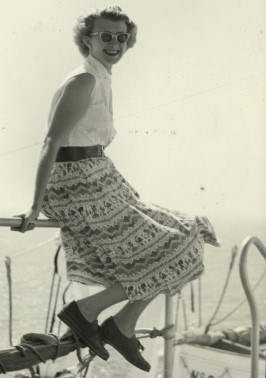
Chidsey Family Photo As the only women ranger-naturalist in Zion at the time, Barbara Chidsey Felton’s fellow coworkers described her as somewhat radical in the workplace. Lorraine Lemmon, the secretary to the superintendent, said this about Barbara in an interview for the 1982 Pioneers of Zion oral history project (Museum Catalog Number: ZION 12352): "The women, I can remember the first lady naturalist. We just didn't quite know about that. Then of course, Barbara Felton was Jim Felton's wife, she was about the "second lady naturalist" we had. Barbara was an eye opener to all of us. She was among the first women libbers, she just used to tickle me. Of course, after she had been there a while, she and Jim sort of paired off and were married. She's still that way, anyone who knows her. She's quite a lady. We enjoyed having her. Then it became quite a natural thing for them to have women naturalists." 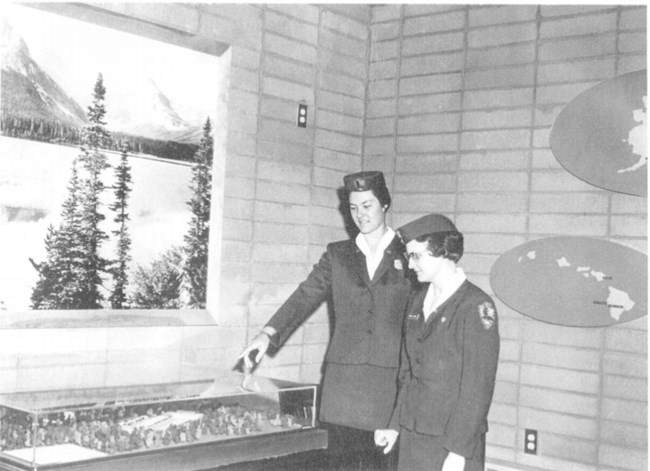
Bermultinational Limited Organization Development and Management Consultants, Albright Administrative History: Program Review, 2008, Horace M. Albright Training Center (2008) pg. 37. By the 1960s, Barbara Lund felt that being a woman naturalist was nothing special. However, there were still discriminatory hiring practices in place that hindered women from becoming official rangers. Following the Civil Rights Act of 1964, which barred discrimination on the basis of sex, the National Park Service allowed two women into their ranger training program at the Grand Canyon. Barbara Lund and the second woman, Barbara Sorrill, completed the 12-week program alongside forty-four other men. Upon finishing the program, Lund worked at Saguaro National Monument for three years, where she was the only uniformed woman on staff. In 1966, she was then reassigned to Zion National Park, where she worked for four years as a ranger-naturalist. At Zion, Lund staffed the information desk, held campfire talks, led guided walks, managed the park library, wrote trail information guides, conducted tours for school groups, and contributed to a variety of field studies in the park. After Zion, she went on to work at Sanford Recreation Area and the Capital Area Parks in DC and has dedicated her more recent years to environmental activism. Today’s Women in the National Park Service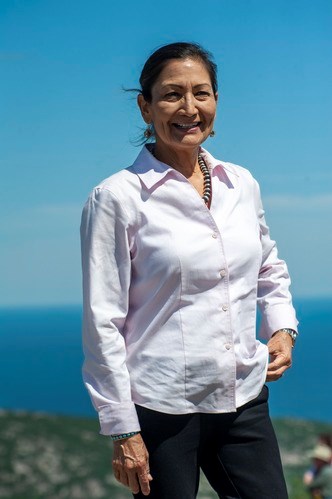
Acadia National Park Photo Thanks to these trail blazing women, there continues to be more and more opportunities for women within the National Park Service. The number of women working in the National Park Service is growing, including in leadership and higher-paying positions. While Gertrude Cooper was the first woman superintendent in the National Park Service in 1940, the number of women who have held the role of superintendent has grown exponentially. In 1983, Georgia Ellard became the first Black women superintendent with Barbara Booher becoming the first Native American woman superintendent in 1990. In 2001, Fran P. Mainella became the first woman Director of the National Park. In 2021, Deb Haaland became the first Native American woman to hold the position of Secretary of the Interior, which oversees many departments including the National Park Service. There is still work to be done for more representation within Zion and the National Park Service overall. Currently more and more parks are working to learn more and share the untold stories with their visitors. Many of these stories involve numerous struggles and challenges that women, people of color and other minorities have faced while working within the National Park Service. 
Zion National Park Photo Links of InterestOral History at Zion
|
Last updated: February 13, 2025
